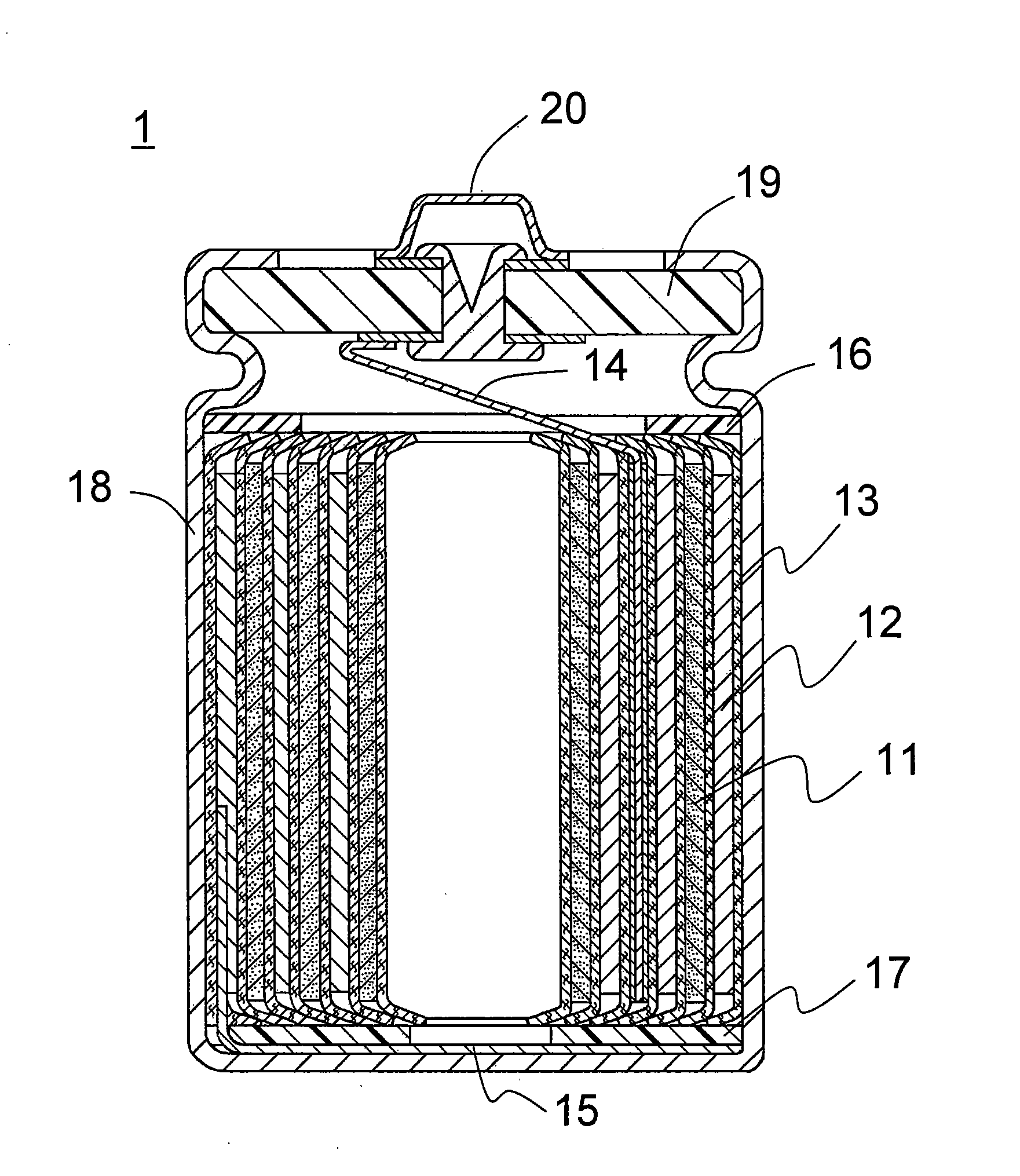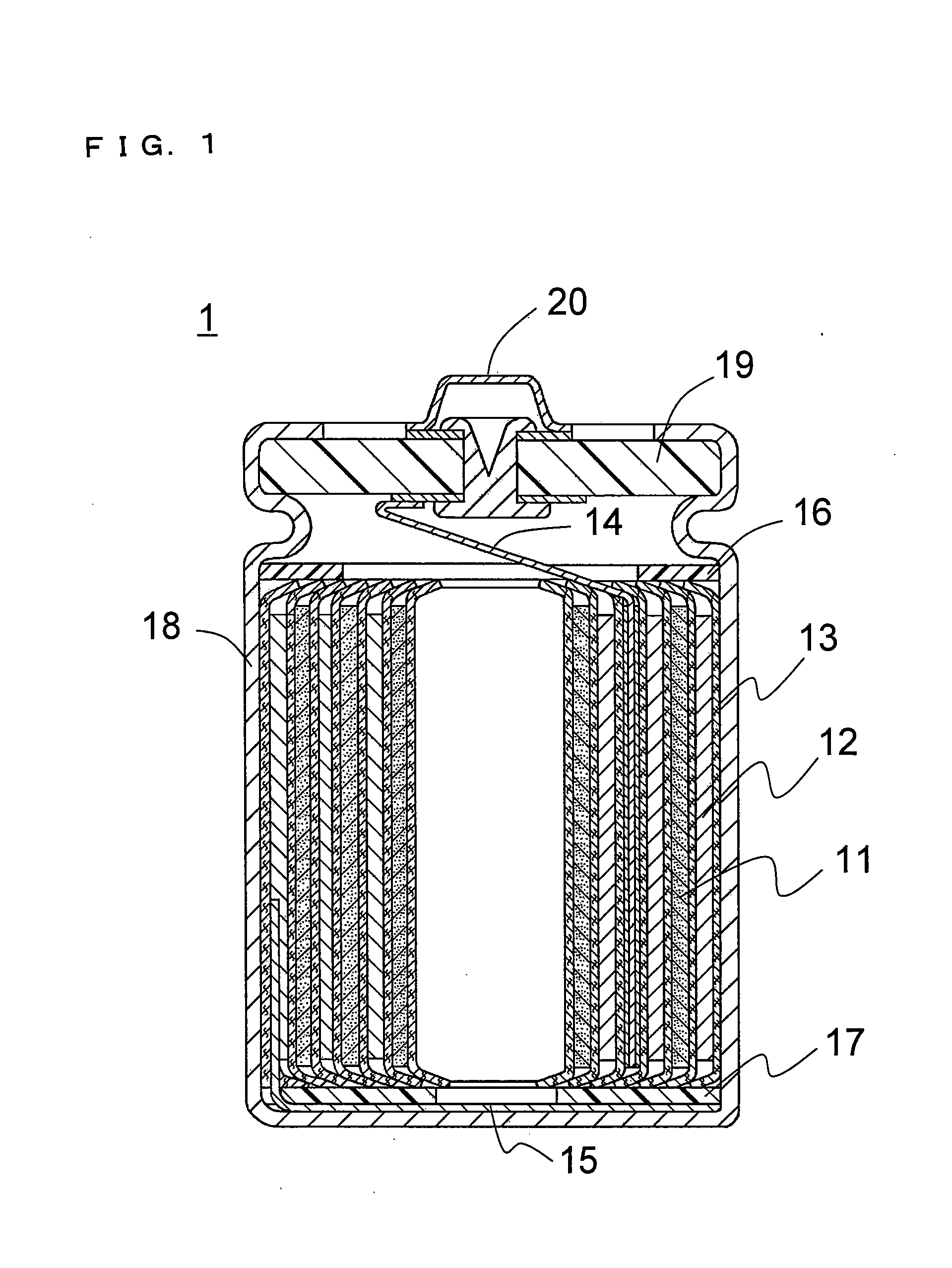Non-aqueous electrolyte and non-aqueous electrolyte secondary battery
a non-aqueous electrolyte and secondary battery technology, applied in the direction of non-aqueous electrolyte cells, cell components, sustainable manufacturing/processing, etc., can solve the problems of low affecting the reliability of non-aqueous electrolyte secondary batteries, and gradual deformation of characteristics, so as to reduce gas generation, improve the wettability of polyolefin separators, and improve the wettability
- Summary
- Abstract
- Description
- Claims
- Application Information
AI Technical Summary
Benefits of technology
Problems solved by technology
Method used
Image
Examples
example 1
Preparation of Single Phase Non-Aqueous Electrolyte and Evaluation of Wettability to Polyolefin Separator
[0086]Non-aqueous solvents selected from the fluorinated ether (1) (abbreviated as “ether (1)” in the following Tables 1 to 8), EC, PC and DMC were used at the content (mol %) listed in Table 1 to prepare mixed solvents. All the resulting mixed solvents were single phase solutions.
[0087]Next, 1 mole (151.9 g) of LiPF6 was dissolved in 1 liter each of the resulting mixed solvents to prepare non-aqueous electrolytes. All the resulting non-aqueous electrolytes were single phase solutions.
[0088]A polyethylene separator was immersed in the thus obtained non-aqueous electrolytes, and the wettability to the separator (described simply as “wettability” in Tables 1 and 2) was evaluated. As for the wettability, it was determined to be “wet” when the separator became translucent as a result of putting a few drops of the non-aqueous electrolyte thereon, and it was determined to be “not wet” ...
example 2
Effect of Non-Aqueous Electrolytes Containing EC and PC in Increasing Wettability to Polyolefin Separator
[0090]The fluorinated ether (1), the fluorinated ether (2a) (abbreviated as “ether (2a)” in Tables 2 to 8), EC and PC were used at the content (mol %) listed in Table 2 as non-aqueous solvents to prepare mixed solvents. 1 mole (151.9 g) of LiPF6 was dissolved in 1 liter each of the mixed solvents to prepare non-aqueous electrolytes. All the resulting non-aqueous electrolytes were single phase solutions. A polyethylene separator was immersed in the thus obtained non-aqueous electrolytes, and the wettability was evaluated. The results are shown in Table 2.
TABLE 2Compositions of Mixed SolventsWettability(q)EC / PC / ether (1) / ether (2a) = 47.5 / 47.5 / 2 / 3Wet(r)EC / PC / ether (1) / ether (2a) = 48.5 / 48.5 / 2 / 2Wet(s)EC / PC / ether (1) / ether (2a) = 49 / 49 / 1 / 1Wet(t)EC / PC / ether (1) / ether (2a) =Not wet49.45 / 49.45 / 1 / 0.1
[0091]From Table 2, it is clear that the non-aqueous electrolytes containing EC, PC, the ...
example 3
Load Characteristics of Secondary Batteries that Include Non-Aqueous Electrolytes Containing Non-Cyclic Carbonate
(1) Preparation of Non-Aqueous Electrolyte
[0092]Non-aqueous electrolytes (a) to (h) were prepared in the same manner as in Example 1.
(2) Production of Positive Electrode
[0093]93 parts by mass of LiNi0.8CO0.13Al0.07O2 powder (a positive electrode active material), 3 parts by mass of acetylene black (a conductive material) and 4 parts by mass of polyvinylidene fluoride (a binder) were mixed. The resulting mixture was dissolved or dispersed in anhydrous N-methyl-2-pyrrolidone to prepare a positive electrode material mixture slurry. This positive electrode material mixture slurry was applied onto the surface of a 15 μm-thick aluminum foil (a positive electrode current collector), dried and rolled, to form a 70 μm-thick positive electrode active material layer, thereby producing a positive electrode sheet. The positive electrode sheet was cut out to a size of 35 mm×35 mm, and ...
PUM
| Property | Measurement | Unit |
|---|---|---|
| mol % | aaaaa | aaaaa |
| mol % | aaaaa | aaaaa |
| mol % | aaaaa | aaaaa |
Abstract
Description
Claims
Application Information
 Login to View More
Login to View More - R&D
- Intellectual Property
- Life Sciences
- Materials
- Tech Scout
- Unparalleled Data Quality
- Higher Quality Content
- 60% Fewer Hallucinations
Browse by: Latest US Patents, China's latest patents, Technical Efficacy Thesaurus, Application Domain, Technology Topic, Popular Technical Reports.
© 2025 PatSnap. All rights reserved.Legal|Privacy policy|Modern Slavery Act Transparency Statement|Sitemap|About US| Contact US: help@patsnap.com


